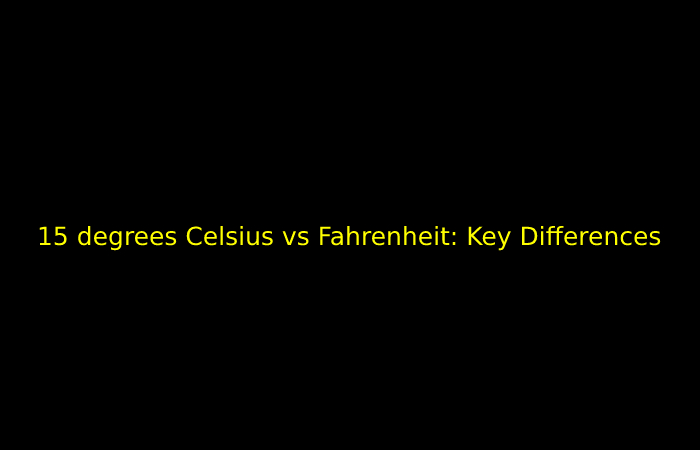Introduction
Here you can find what 15 degrees Celsius to Fahrenheit is, along with a temperature converter and the formula.
For 15 (degrees) Celsius or Centigrade, we write 15 °C, and Fahrenheit (degrees) does denote by the symbol °F.
So if you’ve been looking for between 15 °C and °F, you’re here too.
Read on to learn all about temperature conversion.
15 degrees Celsius vs Fahrenheit: Key Differences

15 degrees Celsius to Fahrenheit before explaining how to convert Celsius to Fahrenheit (and Fahrenheit to Celsius), let’s review the main differences between the two temperature scales.
Celsius (written at °C and called Centigrade) is the world’s most common temperature scale, used by all but five countries. It’s part of the Universal System of Units (SI), or what you might call the metric system, which remains typically used in science lessons (think centimetres, meters, kilograms, millilitres, etc.) and science in general.
In contrast, Fahrenheit (written in °F) remain only officially used in five countries around the world:
- United States
- Belize
- Cayman Islands And also
- Palau
- The Bahamas
Fahrenheit is not part of the metric system; instead, it is part of the imperial system, which includes measurement forms such as inches, feet, pounds, gallons, etc. Also, unlike Celsius, it is not generally used in science.
Celsius to Fahrenheit Formula – 15 degrees Celsius to Fahrenheit
Unfortunately, converting Celsius to Fahrenheit is challenging to do quickly or mentally. Therefore, these methods convert Celsius to Fahrenheit and Fahrenheit to Celsius. These formulas will give you a thorough conversion from one temperature unit to another:
Celsius to Fahrenheit method: (°C * 1.8) + 32 = °F
Fahrenheit to Celsius Method: (°F – 32) / 1.8 = °C
Let’s say the temperature outside is 18°C, and you want to know what it would be in degrees Fahrenheit. It is what your equation would look like once you plug in 18 for °C:
(18*1.8)+32
(32.4) + 32
=64.4°F
Here’s an additional example if you want to convert Fahrenheit to Celsius: Let’s say you’re feeling sick and your body temperature is 101.3°F. To find out what this is in degrees Celsius, plug 101.3 into the °F part of the second equation written above:
(101.3 – 32) / 1.8
(69.3) / 1.8
=38.5°C
As you can see, these conversions aren’t complicated to perform, but they are time-consuming and not the easiest to do without a calculator handy.
Fortunately, there is a shortcut. By learning some of the most common temperatures that occur in daily life, you should have no problem converting from Celsius to Fahrenheit and vice versa. We will see how to proceed below.
What is 15 Degrees in Celsius to Fahrenheit?
So far, we have used the exact formula to change 15 °C to Fahrenheit.
However, in daily life, the approximation formula explained on our home page sometimes meets the need. And also
The approximate Fahrenheit temperature is (15 x 2) + 30 = 60 °F.
There are many types of thermometers, yet a digital or liquid thermometer displays both temperature units remain recommended.
Additional Information about 15 degrees Celsius to Fahrenheit
Anders Celsius, the Swedish astronomer, invented the international temperature scale.
15 degrees Celsius and 15 Celsius without “degree” mean the same thing.
Daniel Gabriel Fahrenheit, a German scientist, is the inventor of the unit of measurement of the same name.
15 degrees Fahrenheit and 15 Fahrenheit without a degree mean the same thing too. And also
Its temperature range remains defined as the degrees between water boiling and freezing. On the other hand, temperatures in kelvins do not have a degree. They are absolute.
In daily life, you will most likely come across the temperature in Celsius or Fahrenheit, such as the temperature of the human body, and to indicate boiling water.
15 Celsius in other temperature units is:
Newton: 4.95°N
Kelvin: 288.15°K
Réaumur: 12 °Ré
Rome: 15,375 °Ro
Delisle: 127.5° From
Classification: 518.67 °R
The temperature unit degrees Kelvin (°K) refers to the absolute temperature scale named after Lord Kelvin.
Conclusion
15 degrees Celsius to Fahrenheit is mainly used in science to express the coldest temperatures or the surface temperature of a very hot object, for example.


